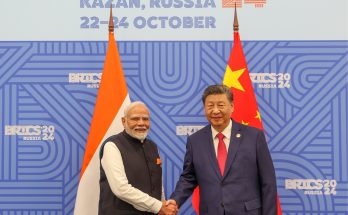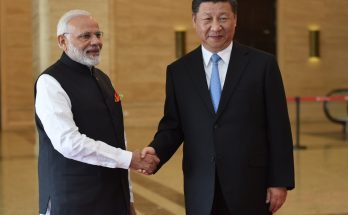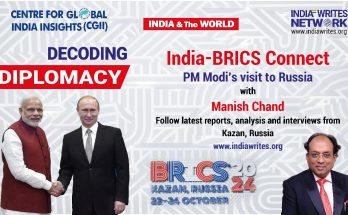
India and Canada are trying to revive momentum in their bilateral relations which drifted for a while due to differences over activities of Khalistani extremists. The way forward lies in building on economic synergies and optimising bilateral cooperation in crucial areas such as agriculture, nuclear energy and infrastructure, says Amb. Vishnu Prakash.

External Affairs Minister (EAM) Dr. S Jaishankar visited Ottawa on 19-20 December 2019, when he met Prime Minister Justin Trudeau and undertook a ‘comprehensive review of bilateral ties’ with his counterpart, François-Philippe Champagne, on turning over a leaf in the relationship. It was high time for doing so and befittingly a proactive India, took the lead in the matter, soon after the May 2019 general elections, which saw the Modi government return to power with an even stronger mandate.
Between June and August, EAM and then Foreign Minister Chrystia Freeland managed to have three rounds of consultations on the margins of international fora. She tweeted (June 28) – “Canada and India are close partners with deep historical and people-to-people ties….” EAM’s similarly observed – “….Look forward to building an even more substantive relationship that reflects both our interests and concerns.”
These high-level engagements, came as a refreshing shower after a long and hot summer that began in February 2018, consequent to the visit of Justin Trudeau to India, when very little went according to the script. Whether EAM’s interactions are a harbinger of green shoots, remains to be seen. But the real question is, how did it come to such a pass? After all, Prime Minister Narendra Modi had paid a landmark visit to Canada in April 2015, after a gap of 42 years, which had elevated the bilateral relations to a strategic partnership.
Cultural & Political Ties

Canada and India are indeed well suited to be strategic partners. Vibrant democracies and multicultural English-speaking societies, both nations are members of the Commonwealth, G20, and ARF (ASEAN Regional Forum), to name a few and have a broad commonality of outlook. The two countries have complementary economies. Discussions are ongoing on concluding a CEPA (Comprehensive Economic Partnership Agreement) and BIPPA (Bilateral Investment Promotion and Protection Agreement), to give our economic ties a qualitative boost.
Canada has been home to the Indian diaspora since the late 19th century. Currently, 1.9 million PIOs (People of Indian Origin) comprise some 5.6% of the Canadian population. Their number is growing steadily. For good or bad, youngsters seem to compete in parts of India, especially Punjab, to migrate to Canada. Canada is the only OECD country, which absorbs some 350,000 immigrants (close to 1% of its population) every year. The largest number comes from India.
The Indian community has carved out a niche for itself by its diligence, language skills, and educational prowess. Many of them occupy senior positions in the educational, financial, business, official and political spheres. A number of them have become dollar billionaires, notwithstanding their humble origin.
Politics comes naturally to them. Currently, at least 20 lawmakers are of Indian origin (the House of Commons has 338 MPs of which the ruling Liberal party has 157). Four of those have been awarded ministerial berths, including the crucial ministries of Defence and Innovation. Realising that the Hindu voter (roughly two-thirds of the diaspora) was drifting away from his Labour party, Prime Minister Trudeau appointed Ms Anita Anand as Minister of Public Services and Procurement. She is the first-ever Hindu minister in Canada’s Federal government.

Significantly, Sikhs constitute just one-third of the Indian diaspora, yet hold 18 of the 20 parliamentary seats. Given their concentration in certain pockets in Canada (like Surrey near Vancouver, as well as, Brampton and Mississauga in the Greater Toronto area) they can easily bag 6 to 8 seats (called ridings in Canada) and impact the outcome in another 8 to 10 seats. Punjabi is the fourth-largest language in Canada. Therein lies the tale of success of this exceptionally enterprising community, but also the root cause of strain in India Canada relations.
The Khalistani Angle
An overwhelming majority of Sikhs retain an affinity for their land of birth, even though they rightly swear allegiance to their country of adoption. A fringe group comprising of Khalistani separatists, however, indulges in anti-India activities from their Canadian safe haven. Though few in numbers, they control the streets and the Gurdwara coffers. They fund separatist activities in India and also contribute generously to the war chest of the Liberal party.
Canadian politicians, especially the Liberals and NDP (headed by Jagmeet Singh, an unabashed India baiter) are beholden to the Khalistani elements and often make an appearance at separatist platforms, where terrorists like Bhindranwale are eulogised. PM Trudeau himself showed up at one such event in Toronto in April 2017, but in the face of a strong Indian reaction has since refrained from doing so.

New Delhi has been raising its concerns with Ottawa regularly, which pleads helplessness due to the right of free speech, under the Canadian constitution. They also point out that under the constitution a province like Quebec has a right to secede if a majority of electorate casts an affirmative vote.
The Canadians promise to investigate specific complaints but nothing ever comes out of it. What is more, Trudeau was accompanied by a large number of Ministers and MPs to India, some of who are known Khalistani sympathisers. Since the activities of the Khalistanis in Canada have a bearing on the unity and integrity of India, it cannot but cast a shadow on the relationship.
The issue comes up in the Indian Parliament ever so often. As recently as in December 2019, the Minister of State for External Affairs tabled the following response in Rajya Sabha (upper house) – “….There is a small fringe group of pro-Khalistan elements in Canada who spread anti-India feelings through their extremist statements and activities….Government of India remains closely engaged with the Government of Canada to address our concerns relating to anti-India activities by the extremist elements”.
Re-engagement
Naturally, bilateral high-level interaction had all but dried up since February 2018, since there is no question of compromising on India’s vital interests. That said, both sides know that the relationship is too important to be left adrift. Currently, 203,000 Indian students are studying in Canada, a stunning increase from 48730 in 2015. There are about 300 MoUs between institutions of higher learning in India and Canada.
Even in the absence of BIPPA, Canadian Pension Funds have cumulatively pledged to invest over 40 billion dollars in India, knowing that her growth story has just about begun. Canada is also vital to India’s quest for energy security. Consequent to the conclusion of a bilateral civil nuclear agreement in June 2010, India has been procuring uranium from Cameco.
There are many areas including science and technology, innovation, IT and biotech, city planning, green, clean and environmental technologies, waste and water management and outer space that the two sides can work together to mutual benefit.
As such, India decided to adopt a two-pronged approach to build on the convergences, while continuing to sensitise the Canadians about the detrimental role of the Khalistani elements.
That is the background in which India and Canada decided to re-engage, leading to the first meeting between EAM and then Foreign Minister Freeland, in Osaka on the margins of the G20 summit in June 2019. Prime Ministers Modi and Trudeau also had a brief pull-aside meeting. PM Modi sent a message of felicitations to PM Trudeau on his return to power, in the wake of the October 2019 federal elections.
Next, as noted above EAM visited Ottawa in December 2019. He tweeted – “Thank PM @JustinTrudeau for a cordial meeting. We agreed to raise the quality of our relationship and chart a path for the next 5 years. Will also work closely in the global arena”.
EAM held detailed discussions with Foreign Minister Champagne. They reviewed opportunities for more productive collaborations in different sectors. He underlined the “importance of respecting our national integrity and unity”. He dwelled on the challenge of terrorism, including cross-border terrorism and provided “an accurate understanding of Jammu & Kashmir developments”. Mr Champagne remarked that “Canada and India enjoy a close relationship anchored in a shared commitment to democracy as well as close people-to-people ties”. He also tweeted on 20th December that his meeting with EAM, “will bring new momentum to our bilateral relationship.”
The Canadian foreign minister is no stranger to India. His first official visit was in March 2017 as minister of International Trade, when he pushed for the early conclusion of BIPPA. Substantial discussions have already been held over the years. Just a couple of clauses – dispute resolution mechanism (legal remedies), ratchet (automatic application of a future change in the laws that is beneficial to investors from either side) and definition of investment (whether short-duration portfolio investments are covered, for example?”) – need to be agreed to.
The Canadian side rightly notes that the Agreement had been finalised, though not signed. Given that the Canadian pension funds cumulatively hold over 800 billion dollars in investable resources, the early conclusion of BIPPA is clearly in India’s interest. That can become a catalyst for infusing a new momentum in the bilateral relationship.
Prime Minister Trudeau heads a minority administration. It is moot if it can survive the full four-year term in office. Similarly, it is not very likely that the Liberals would bring the Khalistani elements to heel. Nevertheless, the highest-level political dialogue needs to be maintained. Both sides need to stay engaged, which could incentivize Ottawa to also view things from the Indian perspective.
- Amb. Vishnu Prakash (retd) served as India’s Ambassador to Canada and South Korea. A well-known commentator on foreign affairs, he also served as spokesperson of India’s Ministry of External Affairs.
(This article has been published in the new edition of India and World, a pioneering magazine focused on international affairs. To subscribe to India and World, write to editor@indiawrites.org
Also check The Magazine section: https://www.indiawrites.org/tgii-modi-fied-foreign-policy/)
IW-march-cover-option
Author Profile
- India Writes Network (www.indiawrites.org) is an emerging think tank and a media-publishing company focused on international affairs & the India Story. Centre for Global India Insights is the research arm of India Writes Network. To subscribe to India and the World, write to editor@indiawrites.org. A venture of TGII Media Private Limited, a leading media, publishing and consultancy company, IWN has carved a niche for balanced and exhaustive reporting and analysis of international affairs. Eminent personalities, politicians, diplomats, authors, strategy gurus and news-makers have contributed to India Writes Network, as also “India and the World,” a magazine focused on global affairs.
Latest entries
 Business with IndiaOctober 25, 2024Modi’s new mantra for blending India’s Dynamism with Germany’s Precision
Business with IndiaOctober 25, 2024Modi’s new mantra for blending India’s Dynamism with Germany’s Precision China ConnectOctober 23, 2024“Our Diversity and Belief in a Multipolar World Are Our Strengths”: PM Modi at BRICS Summit
China ConnectOctober 23, 2024“Our Diversity and Belief in a Multipolar World Are Our Strengths”: PM Modi at BRICS Summit DiplomacyOctober 23, 2024“BRICS: A Beacon of Hope for Global Unity and Reforms “
DiplomacyOctober 23, 2024“BRICS: A Beacon of Hope for Global Unity and Reforms “ DiplomacyOctober 23, 2024Deepening Ties Amidst Global Turmoil: PM Modi Meets Iranian President at BRICS Summit
DiplomacyOctober 23, 2024Deepening Ties Amidst Global Turmoil: PM Modi Meets Iranian President at BRICS Summit






